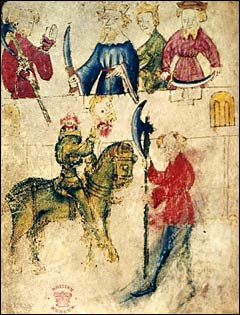|
|
|
|


Sir Gawain and the Green Knight is a Medieval English romance in the Arthurian tradition. The text is thought to have been composed in the mid- to late
fourteenth century. The only extant manuscript, MS. Cotton Nero A.X. in the British Library, is itself a copy of an earlier original, and dates from around 1400. The anonymous
author is today called alternately "The Pearl Poet," after the poem Pearl in the same manuscript, or "The Gawain Poet." The same author is also thought to have composed
the other two poems in the manuscript, Cleanness and Patience. Nothing conclusive is known of the author's identity or biography.
Gawain is a verse romance. Romance takes its name from the French Roman, a moniker used originally for any secular work written in one of the Romance languages;
i.e., languages related to the Roman tongue of Latin—Italian, Spanish, French and Portuguese—the "vulgar tongues" (languages of the people, non-Latin). More
particularly, the term Roman came to be associated with tales of chivalry and courtoisie, such as the Arthurian tales. While the epic hero still coexisted
for some time with the new romantic hero, the changes in society afforded more popularity for the romance. Epic literature was the national or tribal literature of a given
people, the epic hero the defender, the fight being for the survival of the tribe or nation. With the rise of the feudal system and the relative prosperity of the upper
classes, there arose a leisure class who did not have to go out to fight monsters to the death to save their villages—this audience was a courtly one, with time for
niceties, and it wanted heroes who faced fantastical challenges out of choice, not out of a survival instinct. The romantic, or chivalric, hero often is out to find adventure,
he is fighting for an idea, and his demise or potential failure will not result in the demise of a whole nation. So Gawain sets out to find the Green Knight, and undergoes
many trials to his ideals and virtue, as compared with Beowulf who has to fight Grendel and his dam to save his people. (For a fuller treatment of the differences between
the epic and the romantic hero, consult Heroes of the Middle Ages).
Sir Gawain and the Green Knight is written in a North or West Midlands dialect. It is quite a challenge to non-Medievalists—this is why students are likely to
encounter the poem in one of its many modern translations. It is written in long alliterative lines with the rhyme scheme of ababa, in 101 stanzas. In addition to
its appealing subject matter (the interest in tales of King Arthur and the knights of the Round Table having waned little since the Middle Ages), the poem possesses a lyrical
beauty, a flowing artistry, which can only be appreciated in full in the original.
Gawain was first published in 1839, and numerous translations and retellings have appeared since. There are several quality translations currently in print, the best
of which (in this author's opinion) is still Marie Borroff's translation, which first appeared
in 1967, and of which a revised edition was published as a Norton Critical edition in 2009.
Article citation:
Jokinen, Anniina. "Sir Gawain and the Green Knight." Luminarium.
28 Jan 2010. [Date you accessed this article].
<http://www.luminarium.org/medlit/gawainintro.htm>
 | to Luminarium Main |
 | to Middle English Literature |
 | to Luminarium Encyclopedia |
Site copyright ©1996-2023 Anniina Jokinen. All Rights Reserved.
Created by Anniina Jokinen on October 3, 2006. Last updated on January 24, 2023.
|
|
Middle English Literature
Geoffrey Chaucer
John Gower
Sir Gawain and the Green Knight
William Langland / Piers Plowman
Julian of Norwich
Margery Kempe
Thomas Malory / Morte D'Arthur
John Lydgate
Thomas Hoccleve
Paston Letters
Everyman
Medieval Plays
Middle English Lyrics
Essays and Articles
Intro to Middle English Drama
Sciences
Medieval Cosmology
Historical Events and Persons
Hundred Years' War (1337-1453)
Edward III
Edward, Black Prince of Wales
Lionel of Antwerp, Duke of Clarence
John of Gaunt, Duke of Lancaster
Edmund of Langley, Duke of York
Thomas of Woodstock, Gloucester
Richard of York, E. of Cambridge
Richard II
Henry IV
Edward, Duke of York
Henry V
Thomas, Duke of Clarence
John, Duke of Bedford
Humphrey, Duke of Gloucester
Catherine of Valois
Charles VII, King of France
Joan of Arc
Louis XI, King of France
Charles the Bold, Duke of Burgundy
The Wars of the Roses (1455-1485)
Causes of the Wars of the Roses
The House of Lancaster
The House of York
The House of Beaufort
The House of Neville
Henry VI
Margaret of Anjou
Richard Plantagenet, Duke of York
Edward IV
Elizabeth Woodville
Edward V
Richard III
George, Duke of Clarence
More at Encyclopedia and at
Additional Medieval Sources
|
|